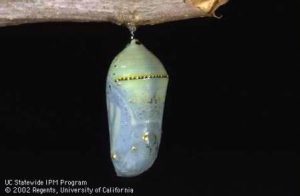From our coastal scrub and valley grasslands, to our chaparral and oaken foothills, and up to our giant sequoias and high Sierra, California remains one of the most diverse flower habitats in the world. It provides essential plants for attracting bees, butterflies, and other pollinators. The monarch butterfly is especially attracted to California native milkweed.
In spring, monarchs head north, and in fall, four generations later, they fly back to overwinter in Mexico. Monarch butterflies begin as eggs that hatch into caterpillars. They eat their eggshells before devouring the milkweed plants they were born on. Molting four to five times, the caterpillars eat their shed skin as they gain 2700 times their original weight in a stage that lasts only 9-14 days.
A monarch caterpillar can eat an entire milkweed leaf in less than five minutes. Twelve hours before shedding its skin for last time, the colorful, fat caterpillar spins a silk thread to hang on. After wiggling upside down – like Houdini in a straitjacket – the outer skin hardens into a protective chrysalis. Two weeks later, the black-orange-and-white magnificent monarch butterfly emerges. For us, the colorful pattern is beautiful, but it warns predators to steer clear of a foul- tasting and poisonous meal.
Milkweed is the best plant for attracting monarch butterflies to the garden. Anywhere is a good place to plant milkweed. California’s native milkweeds feature two species that grow in a wide range of conditions, and are most suitable for monarch restoration efforts. The Narrow-leaved milkweed (Asclepias fascicularis), flowers from May to October and has a pink corolla and white corona. It grows to three feet in dry-to-moist soil in open, sunny areas. Showy milkweed (Asclepias speciosa) looks quite different, but has similar colors, grows to five feet, and flowers until September.
If you can find them, other native options are:
• California milkweed (Asclepias californica), which flowers from April to July, and has a corolla and corona, both pink to purple This grows to a maximum height of three feet.
• Woolly milkweed (Asclepias vestita), which flowers from April to July, has a corolla of yellow or pale green, to white. It grows to a height of two feet.
• Heartleaf milkweed (Asclepias cordifolia), flowers from May to July, and has a corolla of dark pink to purple, and a corona of pink or white. It grows to a height of three feet.
• Woollypod milkweed (Asclepias eriocarpa), flowers from May to October, and has a corolla of cream or yellow, and a corona of white or cream, sometimes tinged with purple. It grows to a height of three feet.
Monarch caterpillars have yellow, black, and white tiger stripes. In your garden, let the caterpillars feed. The milkweeds will show the lacy fringes of caterpillar feasts. Chewed leaves are a great sign of healthy monarchs and they will grow back in a couple weeks.
Plant native flowers so the monarchs have nectar. Natives will use less water and offer monarchs more nectar than non-native plants. Native grasses and shrubs will also shelter the butterflies from weather and predators. Keep pesticides away from this habitat. Pesticides kill the eggs and larvae and can blow over even if sprayed on the far side of your yard.
Livestock note: milkweeds are bitter-flavored, unpalatable, and range animals generally avoid eating them when sufficient forage is available. Depression and diarrhea are the main signs of milkweed poisoning. You do not want hungry animals concentrated in abundant milkweed areas. Milkweed IS NOT in the ten most commonly diagnosed plant poisonings of livestock in California. Don’t feed animals hay containing large amounts of milkweed.
Don Bojnowski is a University of California Cooperative Extension Master Gardener of Calaveras County.
Adapted from Don Bojnowski’s article, “Flight of the Monarch Butterfly”



